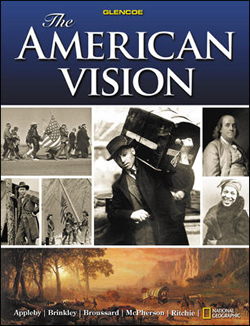
The American Vision © 2008Chapter 26: The Vietnam WarChapter OverviewsThis chapter looks at how the United States involvement in the Vietnam War divided the nation and impacted American society. Section 1 explains the origins of the United States involvement in Vietnam. After the Vietnamese nationalists succeeded in ousting Japanese forces from their land during World War II, their leader, Ho Chi Minh, led a campaign to win Vietnam's independence from French colonial rule. France, unwilling to lose its colonial empire in Southeast Asia, asked the United States for assistance. The Korean War and Ho Chi Minh's Communist ties convinced Truman to begin a massive program of military aid to French forces in Vietnam. However, this support could not keep French forces from crumbling under the Vietminh's guerilla attacks. When a pro-American government refused to hold elections, Ho Chi Minh's army began a struggle to reunify Vietnam. This led the U.S. military to send more aid and advisors to help the South Vietnamese. In 1964 an event in the Gulf of Tonkin provided a reason for escalated American involvement, including combat troops and bombing missions. The Vietcong's strength and stamina surprised the United States, and their use of surprise tactics and guerilla warfare frustrated American troops. American forces countered with chemical weapons and napalm, but by the mid-1960s American casualties mounted, and the Vietcong and North Vietnamese showed no sign of surrendering. Section 2 looks at how the war drew sharp divisions between those who supported the war and those who did not. Many Americans supported the military effort when the first American troops landed in Vietnam in the spring of 1965. As the war dragged on, however, grim television coverage of the war began to conflict with optimistic government reports. Americans grew less confident in President Johnson's administration and less supportive of the war. Young people questioned the draft and refused to serve. Antiwar activists staged teach-ins, protest demonstrations, and marches. As hawks and doves debated the war, troubling events in 1968 sent the nation reeling. A large-scale Communist attack in South Vietnam shook Americans' confidence in the war effort. President Johnson shocked the nation by announcing he would not seek reelection. Then a presidential hopeful and a beloved civil rights leader were assassinated. When violence spread to the Democratic convention, voters looked for a leader who would restore unity and order. They chose Republican Richard Nixon in the 1969 presidential election. Section 3 details the events that led to the end of the Vietnam War. Hoping to bring a diplomatic end to the war, President Nixon authorized secret negotiations between the United States and the North Vietnamese. Nixon's strategy for ending the war included cutting back the number of American troops in Vietnam while increasing air strikes to ensure bargaining power. At home, reports of a civilian massacre and an invasion of Cambodia fueled antiwar opposition and sparked violent demonstrations. Support for the war weakened further when a government report undermined the government's credibility. In 1973 the two sides signed a peace treaty, but two years later South Vietnam fell. The United States paid a heavy price for its involvement in Vietnam. Besides billions of dollars spent and thousands of lives lost, the war led Americans to be more cynical about their government. |  |















